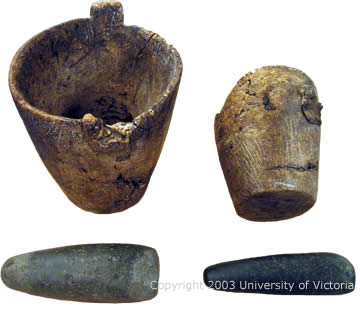

| Previous | Index | Next | |
 |
Unknown (First Nations) Wasco mortars and pestles |
| These are two very early examples of utilitarian
objects from the Northwest Coast. Both were originally collected near
Warm Springs, Oregon, and date from the mid-nineteenth century. They
were objects incorporated into the day to day functions of the Wasco-Wishram
cultural group.
The ancestral land of the Wasco-Wishram is the Columbia River plateau of what is now Oregon. As with most of the resources required by the people, this area supplied wood in abundance. These mortars and pestles are typical of the dug out wood burls of cottonwood which followed the same design technique for cradles and canoes. What nature suggested in the hollowing out of wood was adapted to the needs of the Wasco-Wishram people. These mortars likely had the beginnings of a depression which was augmented through carving, burning or a combination of these techniques. The pestles are ancient indigenous stone, likely basalt, which would outlast many generations of the wooden mortars. Here too, a natural shape in the environment was modified slightly to meet the use it served. The rich patina of the stone attests to its long life of use. These particular mortars were used to mash and pound salmon which was an important and plentiful food resource. They were also used to prepare other fish, meats, roots, grain and other food sources such as camas. Berries were usually mashed into a special dessert in much smaller and wider mortars than these. |
|
| Sponsors: | ||
     |
||
| Copyright © 2004 University of Victoria | Legal notices | Contact Information | Credits | ||